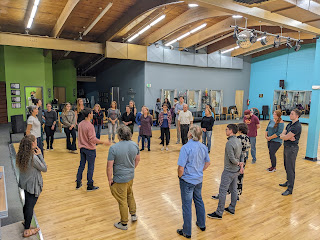January '24 Whips & Dips workshop
This one was two hours long. Lizzy and I each taught one hour, assisting each other for the other portion.
Lizzy's half: Five layers of musicality
Level 0: basic patterns with no frills. Everything is walk walk triple step triple step, no shaping or speed or level changes, accelerations, stops, floating anchors, *nothing at all.* From there, the idea was to add each of the following, one at a time, trying to only use the one tool and not any others. Obviously, this ran into some practical limitations, which was fine.
1. Body angles. Mainly opening out on the second (anchor) triple of each basic... being careful not to lose connection. We talked a little bit about under rotation too but focused on over rotation.
2. Speed changes. Primarily changing your own speed of movement, we talked a little bit about increasing connection to inform your partner but it was mainly giving people awareness in their own bodies to start.
3. Adding, or taking away weight transfers. Taking them away would be tap steps or slides, sweeps etc. Adding more would be doing a triple instead of two walks, or doing four steps in two beats pitter-patter style.
4. Sharp/smooth body movements. At this point, speed changes would most naturally occur as well, but so would body angles. The idea was to try and do this with mostly basic footwork and see what happened (i.e. no delayed rhythms, taking out triples entirely, or syncopated footwork... if possible).
5. Level changes. This one included the basic visual cue of a small movement up to show your partner you were about to do a larger movement down, and vice versa.
All of these tools were given with minimal instruction and cuing, and the class was given music with a medium tempo and easy to find downbeat-upbeat, but lots of texture and layering to play with and try to bring out with the different concepts.
My half: Communicating sides of body
I've written about this before, and taught portions in other workshops. But this was the first time sharing the concept with a large (nearly 40 people), all levels group.
We started with the idea that we want to use our connection to inform our partner as to where we're at. If as a leader, I know where my follower's center of gravity is, especially relative to the slot, I have a much more realistic idea of what I can lead. Also, if my follower wants to do anything at all that isn't exactly what I led, they'll have an easy time letting me know where they're at and what they're doing. From a follower's standpoint, if your leader is actually guiding your weight transfers, a ton of guesswork is taken out. And you're free to create with a much clearer idea of what sort of structure you have to play with.
For followers:
1. Showing leaders where their spine is, through the handhold. That is, putting pressure into the hand without moving it (which would feel heavy), and without relying on that hand for balance. On count four of a six beat basic, this would be over their right foot, on the right side of the slot. From here, as they anchored, leaders should feel the followers center shift to their left foot.
2. This was done in isolation first. The test was to see if leaders could indeed feel this; by closing their eyes, but pointing to where the followers were as they moved. Followers could just do walks, triples, move side to side, try some easy styling, etc.
3. In patterns, we focused on that anchor transition: four to six of a basic. Followers were given the option to open out on their six, or anchor in a closed 3rd.
4. Later on, as leaders started doing more, followers were also freed up to do more and encouraged to try different styling variants on their anchor, without losing connection, informing their partners of their weight transfers the entire time.
For leaders:
1. Connecting their own hand to their center, so that it would move with them as they shifted their center from one foot to the other. From the left side on count four of a basic, to the right on six before leading.
2. The first test was the 'blind-and-point', like the followers. But then the leaders were tasked with bringing their partners with them. If I'm leading and moving from my left to my right foot, can I lead you from your right foot to your left, with me?
3. Then, this was put into basic patterns as well. A basic side to side shift is (relatively) easy, applying it to the dance involves doing it on the back half of a pattern.
4. Finally, leaders were allowed to try this with more patterns. Also, they were given the task of trying to move the four of a right side pass further left than normal (and bringing their follower with them) and doing the same by moving their six to the right.


Comments
Post a Comment